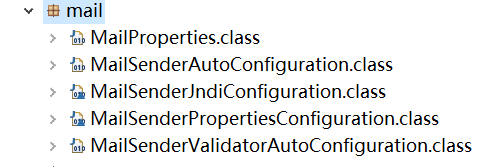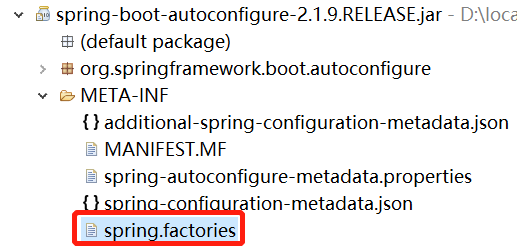在前面我讲用spring-boot-starter-mail发邮件的时候,我侧重看的是spring boot发邮件的便利性,今天,我们聊下另外一个方面,spring-boot-starter自身的结构。
1、看看官方starter的jar里面都有啥
之前使用starter的时候,都是用了就完事了,这次发邮件的时候,好奇心上来了,点开了spring-boot-starter-mail的jar包内容,发现竟然只有一个MANIFEST.MF文件,没有class文件,没有配置文件,非常的简单。

我们看下这个MANIFEST.MF里面都有些啥
Manifest-Version: 1.0
Implementation-Title: Spring Boot Mail Starter
Automatic-Module-Name: spring.boot.starter.mail
Implementation-Version: 2.1.8.RELEASE
Built-By: Spring
Build-Jdk-Spec: 1.8
Created-By: Maven Archiver 3.4.0这个也非常的普通,比平平无奇的古天乐还要平平无奇,这不科学啊。如果只凭这个文件就能发邮件,那我早就靠收藏写真图片娶到新垣结衣了。肯定代码在别的地方,在找代码前,我们先动手自己制作一个starter。
2、突然要开始自己写个starter
自己写个starter也很简单,我们先从https://start.spring.io/下载一个基本的项目结构下来,然后需要修改几个地方。
首先是pom文件要修改,我的pom文件是这样的
<?xml version="1.0" encoding="UTF-8"?>
<project xmlns="http://maven.apache.org/POM/4.0.0"
xmlns:xsi="http://www.w3.org/2001/XMLSchema-instance"
xsi:schemaLocation="http://maven.apache.org/POM/4.0.0 https://maven.apache.org/xsd/maven-4.0.0.xsd">
<modelVersion>4.0.0</modelVersion>
<groupId>com.skyblue</groupId>
<artifactId>mystarter-spring-boot-starter</artifactId>
<version>1.0</version>
<name>mystarter</name>
<description>spring boot starter demo</description>
<properties>
<java.version>1.8</java.version>
</properties>
<dependencyManagement>
<dependencies>
<dependency>
<groupId>org.springframework.boot</groupId>
<artifactId>spring-boot-dependencies</artifactId>
<version>2.1.9.RELEASE</version>
<type>pom</type>
<scope>import</scope>
</dependency>
</dependencies>
</dependencyManagement>
<dependencies>
<dependency>
<groupId>org.springframework.boot</groupId>
<artifactId>spring-boot-autoconfigure</artifactId>
<scope>compile</scope>
</dependency>
<dependency>
<groupId>org.projectlombok</groupId>
<artifactId>lombok</artifactId>
<version>1.18.6</version>
<optional>true</optional>
<scope>provided</scope>
</dependency>
<dependency>
<groupId>org.springframework.boot</groupId>
<artifactId>spring-boot-starter-test</artifactId>
<scope>test</scope>
</dependency>
</dependencies>
<build>
<plugins>
<plugin>
<groupId>org.springframework.boot</groupId>
<artifactId>spring-boot-maven-plugin</artifactId>
</plugin>
</plugins>
</build>
</project>
比起原始的pom.xml,改动了这么几个地方。
<artifactId>mystarter-spring-boot-starter</artifactId>spring 官方的推荐写artifactId的方法是这样
- 官方命名格式为: spring-boot-starter-{name}
- 非官方建议命名格式:{name}-spring-boot-starter
所以,官方用来发mail的starter是spring-boot-starter-mail,我这边用的就是mystarter-spring-boot-starter。
原始pom.xml会有这一段,是需要去掉的,否则打包的时候自己写的类加不进去,jar里面都是spring boot的类
<parent>
<groupId>org.springframework.boot</groupId>
<artifactId>spring-boot-starter-parent</artifactId>
<version>2.1.9.RELEASE</version>
<relativePath /> <!-- lookup parent from repository -->
</parent>另外需要加至少两个依赖进去
<dependencyManagement>
<dependencies>
<dependency>
<groupId>org.springframework.boot</groupId>
<artifactId>spring-boot-dependencies</artifactId>
<version>2.1.9.RELEASE</version>
<type>pom</type>
<scope>import</scope>
</dependency>
</dependencies>
</dependencyManagement>
<dependencies>
<dependency>
<groupId>org.springframework.boot</groupId>
<artifactId>spring-boot-autoconfigure</artifactId>
<scope>compile</scope>
</dependency>
</dependencies>其实把两个依赖都放在<dependencies>节点里面也行,<dependencyManagement>和<dependencies>的区别请自行搜索。
pom.xml改好了后我们需要为自己的starter写class啦,我们这边为了演示,就只实现打印两个值的功能,看代码
public interface MyStarterService {
String getMessage();
Integer getCode();
}
public class MyStarterServiceImpl implements MyStarterService{
@Autowired
private MyStarterProperties myStarterProperties;
public String getMessage() {
return myStarterProperties.getMessage();
}
public Integer getCode() {
return myStarterProperties.getCode();
}
}这个接口和实现类就是简单的返回属性值而已,属性值的配置文件是这样的
@ConfigurationProperties(prefix = "mystarter")
public class MyStarterProperties {
String message;
int code;
public String getMessage() {
return message;
}
public void setMessage(String message) {
this.message = message;
}
public int getCode() {
return code;
}
public void setCode(int code) {
this.code = code;
}
}@ConfigurationProperties注解表示MyStarterProperties 里面的参数message和code都会从配置文件里面读取,prefix = "mystarter"表示配置文件里面参数名称是有前缀的,前缀就是mystarter。举个具体的例子,比如我们之前发邮件的参数也是配置在application.properties,参数的内容是这样的
spring.mail.host=smtp.163.com
spring.mail.port=25
spring.mail.username=youname@163.com
spring.mail.password=yourpassword里面host,port,username,password就是参数的名称,spring.mail就是前缀。
上面这些写好了相当于业务功能部分,现在需要把业务功能申明到spring-boot-starter体系里面去,需要靠下面这个类
@Configuration
//告诉spring容器配置文件读取用MyStarterProperties.class
@EnableConfigurationProperties({MyStarterProperties.class})
//导入业务组件MyStarterServiceImpl
@Import(MyStarterServiceImpl.class)
public class MyStarterAutoConfiguration {
}我用的是最简单的方式,其实spring boot还提供了@Conditional 系列注解实现更加精确的配置加载Bean的条件,这里就不详述了。
最后,我们需要告诉spring boot在哪里去找到这个MyStarterAutoConfiguration ,在resources/META-INF下面建一个spring.factories文件

内容也很简单,就一句而已
org.springframework.boot.autoconfigure.EnableAutoConfiguration=
com.skyblue.mystarter.MyStarterAutoConfiguration这样,其实一个自定义的starter就完成了,用mvn install就可以直接生成一个starter了。
3、回头看spring-boot-starter-mail真正的实现代码
在给starter取名字的时候说了,官方命名格式是有固定格式的。其实官方的便利可不在名字上,而是代码都包含在spring boot的jar里面,我们引入spring boot的依赖时,会自动加载spring-boot-autoconfigure.xxx.jar,打开这个jar,就可以看到mail的真正代码了

有没有一种很熟悉的感觉,MailProperties和上面的MyStarterProperties,MailSenderAutoConfiguration和上面的MyStarterAutoConfiguration,显然都是一样按照spring boot starter的规则写的,只是这个官方starter的代码不放在starter的jar包,而是包装到了spring-boot-autoconfigure的jar里面,我们看下MailSenderAutoConfiguration的源代码,可以看到它就用到了@Configuration、@EnableConfigurationProperties、@Import,还用到了我们没用到的@Conditional注解
@Configuration
@ConditionalOnClass({ MimeMessage.class, MimeType.class, MailSender.class })
@ConditionalOnMissingBean(MailSender.class)
@Conditional(MailSenderCondition.class)
@EnableConfigurationProperties(MailProperties.class)
@Import({ MailSenderJndiConfiguration.class, MailSenderPropertiesConfiguration.class })
public class MailSenderAutoConfiguration {
/**
* Condition to trigger the creation of a {@link MailSender}. This kicks in if either
* the host or jndi name property is set.
*/
static class MailSenderCondition extends AnyNestedCondition {
MailSenderCondition() {
super(ConfigurationPhase.PARSE_CONFIGURATION);
}
@ConditionalOnProperty(prefix = "spring.mail", name = "host")
static class HostProperty {
}
@ConditionalOnProperty(prefix = "spring.mail", name = "jndi-name")
static class JndiNameProperty {
}
}
}
还有一个spring.factories文件,也可以在spring-boot-autoconfigure.jar里面找到

在里面,我们可以看到完整的spring boot官方starter的AutoConfiguration类列表
# Auto Configure
org.springframework.boot.autoconfigure.EnableAutoConfiguration=
org.springframework.boot.autoconfigure.admin.SpringApplicationAdminJmxAutoConfiguration,
org.springframework.boot.autoconfigure.aop.AopAutoConfiguration,
org.springframework.boot.autoconfigure.amqp.RabbitAutoConfiguration,
org.springframework.boot.autoconfigure.batch.BatchAutoConfiguration,
org.springframework.boot.autoconfigure.cache.CacheAutoConfiguration,
org.springframework.boot.autoconfigure.cassandra.CassandraAutoConfiguration,
org.springframework.boot.autoconfigure.cloud.CloudServiceConnectorsAutoConfiguration,
......我这边就不全列出来了,大家根据这个去找需要的官方starter就比较方便了。
4、猛回头我们调用下我们的自定义starter
我们另外用https://start.spring.io/再创建一个项目,然后在pom.xml里面加载starter的依赖
<dependency>
<groupId>com.skyblue</groupId>
<artifactId>mystart</artifactId>
<version>1.0</version>
<type>jar</type>
<scope>system</scope>
<systemPath>D:\workspace\mystart\target\mystarter-spring-boot-starter-1.0.jar</systemPath>
</dependency>我为了图方便,就直接用pom.xml调用了本地打包的starter包,如果有maven的私服,就可以正常引入。配置application.properties文件
mystarter.message=hello world!
mystarter.code=42写一个调用starter的类
@Service
public class TestService {
@Resource
private MyStarterService myStarterService;
public void message() {
System.out.println("code:" + myStarterService.getCode());
System.out.println("message:" + myStarterService.getMessage());
}
}启动spring boot 查看结果
@SpringBootApplication
public class StartdemoApplication {
public static void main(String[] args) {
ApplicationContext context = SpringApplication.run(StartdemoApplication.class, args);
((TestService)context.getBean("testService")).message();
}
}console可以看到打印出来的message和code
. ____ _ __ _ _
/\ / ___'_ __ _ _(_)_ __ __ _
( ( )\___ | '_ | '_| | '_ / _` |
\/ ___)| |_)| | | | | || (_| | ) ) ) )
' |____| .__|_| |_|_| |_\__, | / / / /
=========|_|==============|___/=/_/_/_/
:: Spring Boot :: (v2.1.9.RELEASE)
2019-10-10 22:13:49.521 INFO 21952 --- [ main] c.w.startdemo.StartdemoApplication : Starting StartdemoApplication on skyblue with PID 21952 (D:workspacestartdemo argetclasses started by wphmo in D:workspacestartdemo)
2019-10-10 22:13:49.527 INFO 21952 --- [ main] c.w.startdemo.StartdemoApplication : No active profile set, falling back to default profiles: default
2019-10-10 22:13:50.405 INFO 21952 --- [ main] c.w.startdemo.StartdemoApplication : Started StartdemoApplication in 1.353 seconds (JVM running for 1.983)
code:42
message:hello world!这样,一个完整的自定义starter就运行成功了。